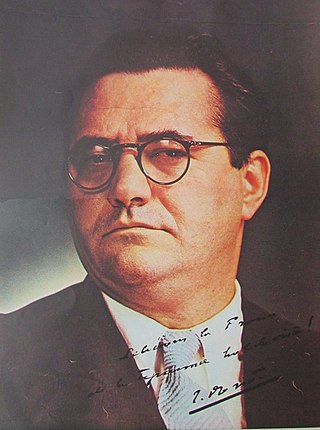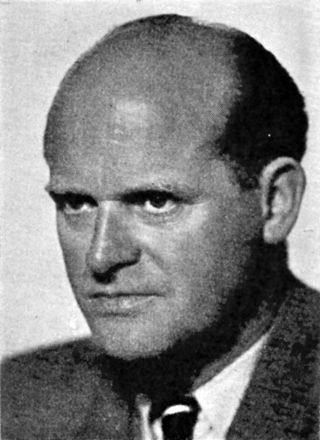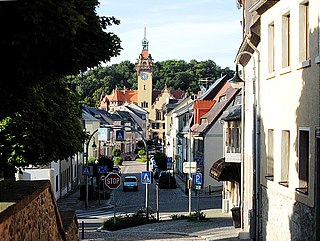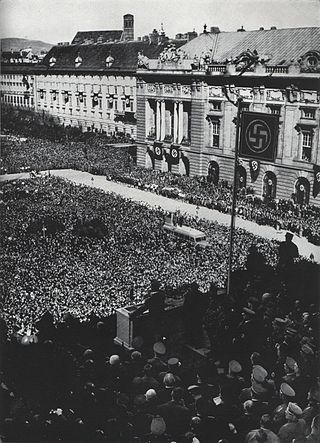
Kurt Josef Waldheim was an Austrian politician and diplomat. Waldheim was the Secretary-General of the United Nations from 1972 to 1981 and president of Austria from 1986 to 1992. While he was running for the latter office in the 1986 election, the revelation of his service in Greece and Yugoslavia, and participation in Nazi atrocities, as an intelligence officer in Nazi Germany's Wehrmacht during World War II, raised international controversy.

The national flag of Germany is a tricolour consisting of three equal horizontal bands displaying the national colours of Germany: black, red, and gold. The flag was first sighted in 1848 in the German Confederation. The flag was also used by the German Empire from 1848 to 1849. It was officially adopted as the national flag of the German Reich from 1919 to 1933, and has been in use since its reintroduction in Federal Republic of Germany in 1949.

The Guelphs and Ghibellines were factions supporting respectively the Pope and the Holy Roman Emperor in the Italian city-states of Central Italy and Northern Italy during the Middle Ages.

The Communist Party of Austria is a communist party in Austria. Established in 1918 as the Communist Party of German-Austria (KPDÖ), it is one of the world's oldest communist parties. The KPÖ was banned between 1933 and 1945 under both the Austrofascist regime and the Nazi German administration of Austria after the 1938 Anschluss.

In politics, a defector is a person who gives up allegiance to one state in exchange for allegiance to another, changing sides in a way which is considered illegitimate by the first state. More broadly, defection involves abandoning a person, cause, or doctrine to which one is bound by some tie, as of allegiance or duty.

A red star, five-pointed and filled, is a symbol that has often historically been associated with communist ideology, particularly in combination with the hammer and sickle, but is also used as a purely socialist symbol in the 21st century. It has been widely used in flags, state emblems, monuments, ornaments, and logos.

Alfred Sinowatz was an Austrian historian and politician of the Social Democratic Party (SPÖ), who served as Chancellor of Austria from 1983 to 1986. Prior to becoming Chancellor, he had served as Minister of Education from 1971 to 1983 and Vice-Chancellor from 1981 to 1983.

Jacques Doriot was a French politician, initially communist, later fascist, before and during World War II.

Leon Rupnik, also known as Lav Rupnik or Lev Rupnik was a Slovene general in the Kingdom of Yugoslavia who collaborated with the Fascist Italian and Nazi German occupation forces during World War II. Rupnik served as the President of the Provincial Government of the Nazi-occupied Province of Ljubljana from November 1943 to early May 1945. Between September 1944 and early May 1945, he also served as chief inspector of the Slovene Home Guard, a collaborationist militia, although he did not have any military command until the last month of the war.
The Austrian resistance launched in response to the rise of the fascists across Europe and, more specifically, to the Anschluss in 1938 and resulting occupation of Austria by Germany.

Nils Svante Flyg was a Swedish Communist politician who turned pro-Nazi during World War II.
A private army is a military or paramilitary force consisting of armed combatants who owe their allegiance to a private person, group, or organization, rather than a nation or state.

Simon Wiesenthal was a Jewish Austrian Holocaust survivor, Nazi hunter, and writer. He studied architecture and was living in Lwów at the outbreak of World War II. He survived the Janowska concentration camp, the Kraków-Płaszów concentration camp, the Gross-Rosen concentration camp, a death march to Chemnitz, Buchenwald, and the Mauthausen concentration camp.

The Slovene Home Guard was a Slovene anti-Partisan collaborationist militia that operated during the 1943–1945 German occupation of the formerly Italian-annexed Slovene Province of Ljubljana. The Guard consisted of former Village Sentries, part of Italian-sponsored Anti-Communist Volunteer Militia, re-organized under Nazi command after the Italian Armistice of September 1943.

Waldheim is a town in Mittelsachsen district, in Saxony, Germany.

The 1944 Romanian coup d'état, better known in Romanian historiography as the Act of 23 August, was a coup d'état led by King Michael I of Romania during World War II on 23 August 1944. With the support of several political parties, the king removed the government of Ion Antonescu, which had aligned Romania with Nazi Germany, after the Axis front in northeastern Romania collapsed in the face of a successful Soviet offensive. The Romanian Army declared a unilateral ceasefire with the Soviet Red Army on the Moldavian front, an event viewed as decisive in the Allied advances against the Axis powers in the European theatre of World War II. The coup was supported by the Romanian Communist Party, the Social Democratic Party, the National Liberal Party, and the National Peasants' Party who had coalesced into the National Democratic Bloc in June 1944.

Austria was part of Nazi Germany from 13 March 1938 until 27 April 1945, when Allied-occupied Austria declared independence from Nazi Germany.

Ohrana were armed collaborationist detachments organized by the former Internal Macedonian Revolutionary Organization (IMRO) structures, composed of Bulgarians in Nazi-occupied Greek Macedonia during World War II and led by officers of the Bulgarian Army. Bulgaria was interested in acquiring Thessalonica and Western Macedonia, under Italian and German occupation and hoped to sway the allegiance of the 80,000 Slavs who lived there at the time. The appearance of Greek partisans in those areas persuaded the Axis to allow the formation of these collaborationst detachments. However, during late 1944, when the Axis appeared to be losing the war, many Bulgarian Nazi collaborators, Ohrana members and VMRO regiment volunteers fled to the opposite camp by joining the newly founded communist SNOF. The organization managed to recruit initially 1,000 up to 3,000 armed men from the Slavophone community that lived in the western part of Greek Macedonia.

The Anschluss, also known as the Anschluß Österreichs, was the annexation of the Federal State of Austria into the German Reich on 13 March 1938.

The victim theory, encapsulated in the slogan "Austria – the Nazis' first victim", was the 1949–1988 Austrian ideological basis formed by Austrians themselves under Allied occupation and independent Second Austrian Republic. According to the founders of the Second Austrian Republic, the 1938 Anschluss was an act of military aggression by the Third Reich. Austrian statehood had been interrupted and therefore the newly revived Austria of 1945 could not and should not be considered responsible for the Nazis' crimes in any way. The "victim theory" that had formed by 1949 insisted that all of the Austrians, including those who strongly supported Hitler, had been unwilling victims of the Nazi regime and were therefore not responsible for its crimes.

















